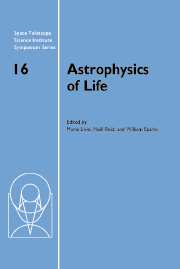 Astrophysics of Life
Astrophysics of Life Published online by Cambridge University Press: 29 August 2009
Interstellar material surrounding an extrasolar planetary system interacts with the stellar wind to form the stellar astrosphere, and regulates the properties of the interplanetary medium and cosmic ray fluxes throughout the system. Advanced life and civilization developed on Earth during the time interval when the Sun was immersed in the vacuum of the Local Bubble and the heliosphere was large, and probably devoid of most anomalous and galactic cosmic rays. The Sun entered an outflow of diffuse cloud material from the Sco-Cen Association within the past several thousand years. By analogy with the Sun and solar system, the Galactic environment of an extrasolar planetary system must be a key component in understanding the distribution of systems with stable interplanetary environments, and inner planets which are shielded by stellar winds from interstellar matter (ISM), such as might be expected for stable planetary climates.
Introduction
Our solar system is the best template for understanding the properties of extrasolar planetary systems. The interaction between the Sun and the constituents of its galactic environment regulates the properties of the interplanetary medium, including the influx of interstellar matter (ISM) and galactic cosmic rays (GCR) onto planetary atmospheres. In the case of the Earth, the evolution of advanced life occurred during the several million year time period when the Sun was immersed in the vacuum of the Local Bubble (Frisch & York 1986, Frisch 1993). Here we use our understanding of our heliosphere to investigate the astrospheres around extrasolar planetary systems.
To save this book to your Kindle, first ensure [email protected] is added to your Approved Personal Document E-mail List under your Personal Document Settings on the Manage Your Content and Devices page of your Amazon account. Then enter the ‘name’ part of your Kindle email address below. Find out more about saving to your Kindle.
Note you can select to save to either the @free.kindle.com or @kindle.com variations. ‘@free.kindle.com’ emails are free but can only be saved to your device when it is connected to wi-fi. ‘@kindle.com’ emails can be delivered even when you are not connected to wi-fi, but note that service fees apply.
Find out more about the Kindle Personal Document Service.
To save content items to your account, please confirm that you agree to abide by our usage policies. If this is the first time you use this feature, you will be asked to authorise Cambridge Core to connect with your account. Find out more about saving content to Dropbox.
To save content items to your account, please confirm that you agree to abide by our usage policies. If this is the first time you use this feature, you will be asked to authorise Cambridge Core to connect with your account. Find out more about saving content to Google Drive.